Interview: How did it start?
The new groundbreaking idea that is now running in many countries around the world was first brought to life in Copenhagen in 2013
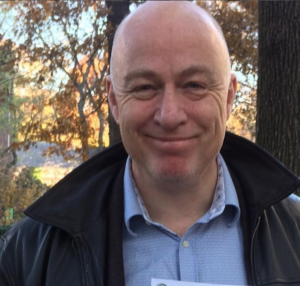
How did you get the idea for Talking Statues David?
To understand the creative development of Talking Statues…I knew that the statues had many good background stories of the statues in Copenhagen, but the problem was how to get them told…
I work as a television producer and often thinking about where the next untold told story may be found, I sore a possability to make films… About the same time I got the book, “Sculptures in Copenhagen” by Jens Peter Munk, who works in the municipality of Copenhagen, and it became clear to me, here were where hundreds of untold stories…
How would I communicate the stories to the audience? The best picture I can give is trying to get water to a village in the mountains from a lake at the bottom. How would it be possible the water brought up to the village? In the same way with Talking Statues, I wanted people to stop at the statues and listen to their stories, but it is just as hard as getting the water up the mountain.
I then got creative. There are good stories behind all the statues. I knew the people would be interested in listening to the stories if they were delivered in the right way, so in the same way..
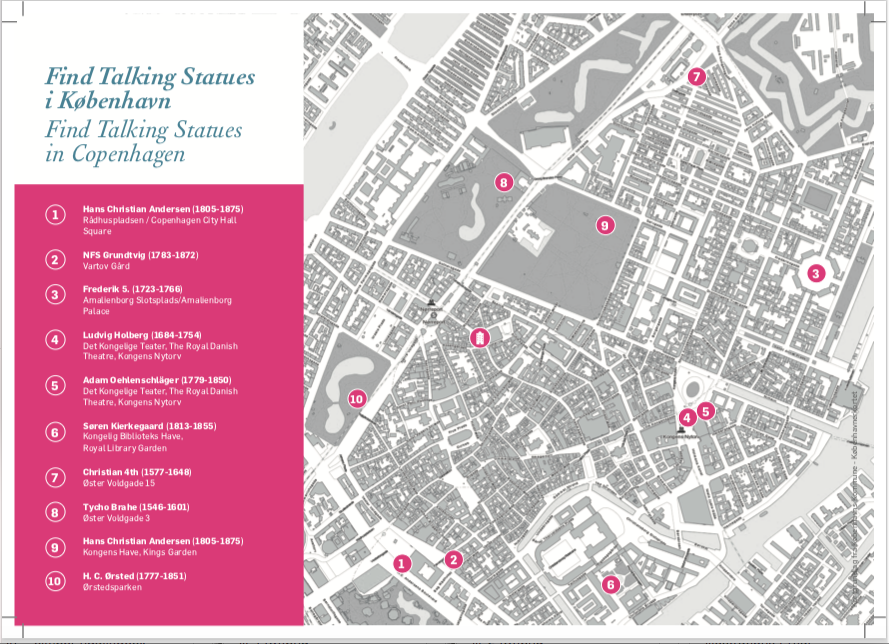

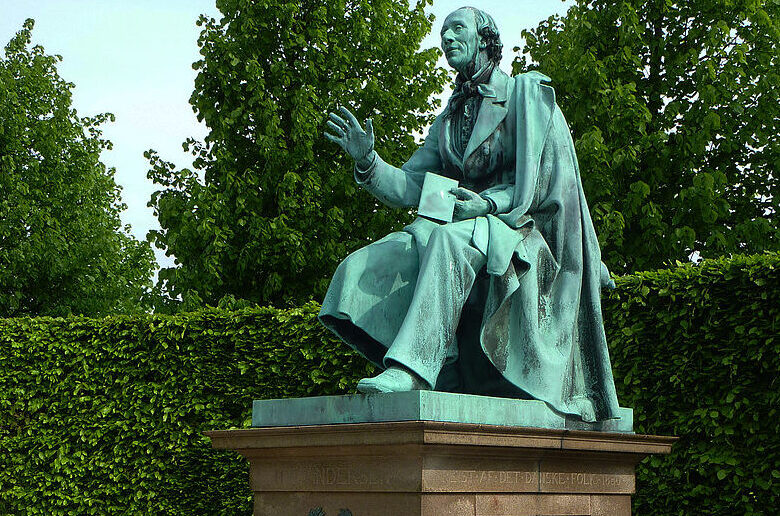
Folder from the first Talking Statues, started in Copenhagen in 2013. Folder made possible by productions assistent Mathilde Lunderskov with support from City of Copenhagen. The folder was distributed to all libraries in Copenhagen and was sent to the press both in Denmark and internationally.
My first idea was to make small films to be downloaded at the statues, since I am a filmmaker, but I quickly understood that this would be too difficult and also to make a statue interesting, you would have to film it in 100 ways – show it from 100 angles within 2 minutes….
Technically it would also be expensive to download and also it would be very convenient and may not get a very big interest. Also, the sunlight would make it difficult to see the films outside on a smartphone – so I suddenly got the idea that they should talk…
This was the breaking point of making the idea, now I just had to find out how to make it happen technically. The national Paper Politiken wrote an article about my project and then I was called the same day by Jesper Stuhr who suggested using QR codes. I then wrote a monologue myself for Hans Christian Andersen, had it recorded and sent an application to Copenhagen City Hall at the end of 2012. I was funded and then the work making the monologues with scriptwriter Carsten Rudolf and directing started…We launched the project in Kings Garden i September 13th, 2013.
Why are the statues so important to you? For example, why did you decide to let exactly the statues talk?
Well, I think that since the statues are all around and they all represent a part of our history, I thought it would be an interesting platform for letting people learn the history of their city. The fact is you are outside and these statues they often are placed in an important place as a part of their story. But the main reason was that they stand there and they have a lot to tell us.
In my opinion, all the statues have a lot of history, they are very interesting. One thing is that they all reflect a part of our history, a time, but many of them are also historical persons like Beethoven or Shakespeare, and so they both have a story and the statues are also a reflection of the time they were erected and made. In New York, it is very interesting that many of the statues have been raised by the people who came to New York as immigrants – Like Hans Christian Andersen in Central Park was funded by Danish immigrants, Ludvig Van Beethoven also in Central Park by Germans, Giovanni da Verrazano at Battery Park by Italians, etc.
What are the main obstacles you have faced during the project? How did you solve them?
The problem was I knew there was a good story; I had to get a story out. I had to find a way to make the statues talk. (…) Also, I had a problem getting finance for the project. I applied for some money and I got 80 000 DKK from the City of Copenhagen. First, they said there was no money, but later the application was discussed by the politicians and finally, I got some money. I had hoped to get more money, but I didn’t get any more money. I applied for money at all institutions in Denmark and all the funds and foundations and I didn’t get anything at all. So, I ended up with my 80 000 DKK.
I started my work and the first thing was to develop the app. It was very expensive. Then suddenly a guy called me up. His name was Jesper Stuhr he told me about a product he sold where you use QR codes. I had never thought about it, he told me that it would be much cheaper and easier to use. This was the second breaking point in creative development. The QR codes worked perfectly and since then they have been used on all Talking Statue projects around the world. We had to pay, I think, 50.000 DKK and then I still would have to take pictures, do research, to get the history of the statues, we still would have to write the monologues, we had to get the actors, studio, etc. I had to use my savings and income on developing the idea. Also, the writing of the monologues needed to be thought through – I got help from an old friend Carsten Rudolf. I had to figure out, what would the statues say if it calls to talk? How would the statues talk? Overall the idea for the Talking Statue project was that there would be a pre-recorded voice made by an actor, but we needed to find out what the length should be, and how the statue would address the public – the passers-by. We had to create a universe – How would the statue relate to the present? We ended up creating the statues as ghosts, they could also relate to the present. Also, the statues would share our feelings of failure, success, and loneliness – we made them human as well. The project is now working in many cities and the universe is the same. Every time I start a project, people always say, good idea, but what will the statues say…
My idea wasn’t to try to make money on this. I was hoping I would get paid for what I was doing but I didn’t. Actually, I spent a lot of money, maybe 4-5 times the amount I got from the City of Copenhagen to make this project possible. Peter Heede from Adaptor Dubbing in Copenhagen was a great help finding good actors. We used only one actor for all the statue voices because of the economy, but it worked very well anyway. My scriptwriter Carsten Rudolf worked for almost nothing to write the 10 monologues.
What did you do with marketing?
We did not do so much, because we had no money, so we just sent out a press release. 6 months later, other countries started calling me, first the City of Helsinki and then London – I thought I would finally get my reward….(laughs) but they just wanted to take the idea and make it by themselves…also without giving credit… but then I started to write to the different institutions and people are now crediting and starting to understand that the idea was made for the first time in Copenhagen in September 2013, Helsinki and London both started in 2014 and then came Berlin, Vilnius, Chicago, San Diego, Manchester, Dublin and finally New York, which I made.
How would you describe the technical development of the project?
The idea was at the beginning that the system should work on GPS which means as soon as you got close to the statues, you would catch the voice, but it turned out to be too expensive and we were almost finished developing this app and then the company which was going to make it couldn’t do it for the money we could offer. They were very interested in doing it, but the hours were too many and the pay was too low. So we had to stop the project and then suddenly I got an email from Jesper Stuhr and he worked at a company called Scanbuy developing QR codes – he asked me why didn’t I do it with QR code instead? So, I had a meeting with Jesper Stuhr from Scanbuy. He offered to do this QR code system and make a mobile app which is much cheaper for only 45.000 DKK, which was very good for me because then I would still have some money left for developing the rest of the project. So this was something that would be very easy to use and it worked very well. The other advantage was you could use two languages, you could program the QR code so it would read what kind of language you have on your telephone and it would play the message in that language. You could do all kinds of statistics, see who is using QR codes, etc. It seemed that the water had not only been brought to the village. The project had to find a way to get the water up the mountain and finally, we had success. As this problem was solved, everything else fell in place right after.
After the project was launched, did you work on the project’s development and its geographical expansion? If yes, how did it go?
Well, we wanted to expand and we wanted to make it international. That was the aim of the project. We chose the international name, Talking Statues, we also bought www.talkingstatues.com, and also Twitter address www.twitter.com/talkingstatues and we also wanted to register it as a trademark to work around the world. The project started in September 2013 in Copenhagen as the first Talking Statues project in the world. There had never been anything similar made before. After the project started, in November 2013, we were called by Helsinki. They wanted to do the same project and we were called by London, Sing London, who wanted to do the same project. Sing London has sent us an email address, it was Colette Heller, the director of Sing London who called me.
I thought we were going to work together in London to do the project, but as I spoke to her, she asked me a lot of questions. It seemed that she didn’t want us to be a part of the project. She wanted to do the project on her own, and then I was a little discouraged. I said it wasn’t so nice because we made the project, etc. and I said to them; in this case, don’t use our identity Talking Statues.
How do you see the future of this project?
I would very much like to help to get the project started in new cities around the world and make it global. I am starting to get paid now for my work and concept – I am just finishing a statue at Times Square in New York and I have also been paid by the Robert Burns Foundation, but of course, it is also a personal satisfaction to see an idea I made being used all over the world, but it works better with payment.
One friend asked me, as I started – Why did no one get this idea before, it seems so obvious? I had no answer. – I just got the idea when I was walking my kids, Alfred Hauch Fox and Leah Hauch Fox, to kindergarten through Kings Garden in Copenhagen – looking at all the statues in the park – wondering what the statues would say if they could talk. I did not know how it would develop; I was just driven by my creativity and needed to tell good stories
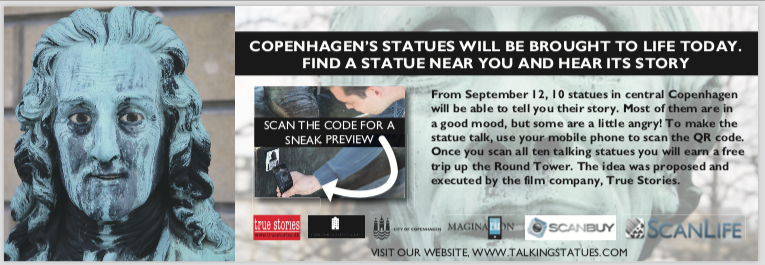
Add brought 12th of September 2013 in the English-language newspaper The Copenhagen Post printed regularly in Denmark, revealing the idea for the first time in the world in public, refering to this website www.talkingstatues.com


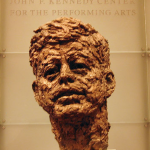


Mission
Our mission is to revitalize history.
Vision
Our vision is that one day there will be no past, present and future – everything will be mixed.
Values
- Precision
- Good service
- Professionalism.
